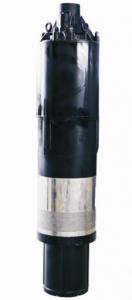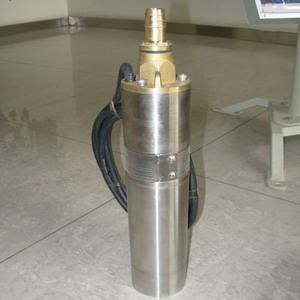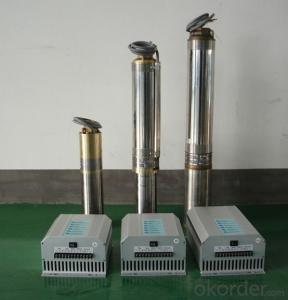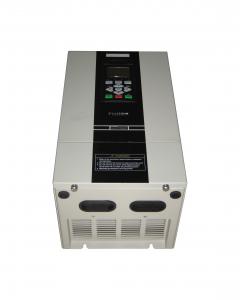Eco Worthy Solar Pump - Solar Water Heater Panels & Solar Powered Submersible Pumps
- Loading Port:
- Shanghai
- Payment Terms:
- TT OR LC
- Min Order Qty:
- 1 set
- Supply Capability:
- 1000 set/month
OKorder Service Pledge
OKorder Financial Service
You Might Also Like
Solar Water Heater Panels Solar Powered Submersible Pumps
DC solar water pumping system consists of the motor, pump, controller, solar array and some other accessories, such as water level sensor, float switch, etc. Considered that storing water is more efficient than storing electricity, the system is designed to directly drive the pump without battery which can reduce the construction and operating cost and routine maintenance effectively.The PV array consists of multiple solar panels connected in series/parallel, which can supply the whole system as power source by converting the absorbed solar radiation energy to the electrical energy. The pump driven by a brushless DC permanent magnet motor draws water from deep-well or river. The pumped water is then fed into reservoir or water tank, or connected to the irrigation system or fountain system directly.
Advanced Technology
Applications Innovation
The efficiency of DC brushless permanent magnet motor has been increased up to 25% in comparison with traditional asynchronous motor.
Technology Innovation
Stator and rotor are sealed by environment friendly casting resin.Motor insulation resistance can be hold higher than 300MΩfor more than 10 years, which consumedly increased the security and reliability of the submersible motor.
Structure Innovation
Casting resign technology processed stator and rotor as well as the water lubricated bearing make the submersible pump environment friendly.
Feature
High Efficiency & High Reliability
DC Brushless Permanent Magnet Motor
Minimum Maintenance, long Service Life
Environment Friendly Materials, Lubricated Without Oil
Application
Village or Family Water Supply
Animal Drinking Water & Livestock Watering
Garden/Courtyard Irrigation
Swimming Pool
Water Supply for Bivouac or Camping Car
Water Supply for Remote Area
Automatic Control
Operate Automatically, No Need Watching
Maximum Power Point Tracking (MPPT)
Dry-run Protection






- Q: Can a solar pump be used in off-grid homes?
- Yes, a solar pump can be used in off-grid homes. Solar pumps are an excellent option for off-grid living as they rely on solar energy to operate, eliminating the need for grid electricity. They can be used to pump water for various purposes such as irrigation, drinking water, or livestock. Solar pumps are cost-effective, environmentally friendly, and provide a reliable source of water in remote areas where access to electricity is limited or unavailable.
- Q: Are solar pumps suitable for use in orchards?
- Yes, solar pumps are suitable for use in orchards. Solar-powered pumps provide a sustainable and cost-effective solution for irrigation needs in orchards, as they utilize clean and renewable energy from the sun. They can effectively supply water to fruit trees, ensuring proper hydration and maximizing crop yield while reducing operating costs and environmental impact.
- Q: Are solar pumps suitable for use in cold climates?
- Yes, solar pumps can be suitable for use in cold climates. While extreme cold temperatures may affect their performance, solar pumps are designed to withstand freezing temperatures and continue operating efficiently. Additionally, advancements in technology have made solar pumps more resilient to cold weather conditions, allowing them to function reliably even in colder climates.
- Q: How does a solar pump help in reducing electricity bills?
- A solar pump helps in reducing electricity bills by utilizing solar energy to power the pump instead of relying on electricity from the grid. This eliminates the need for consuming conventional electricity, which in turn reduces the amount of electricity consumed and ultimately leads to lower electricity bills.
- Q: Are there any government incentives or rebates available for installing a solar pump?
- Yes, there are government incentives and rebates available for installing a solar pump. These incentives vary depending on the country and region, but they typically include tax credits, grants, and subsidies that can significantly offset the cost of installing a solar pump. It is advisable to check with the local government or relevant agencies to get accurate information about the specific incentives available in your area.
- Q: Can a solar pump be used for water supply in a farm or agricultural land?
- Certainly, a solar pump can be utilized for water supply in a farm or agricultural land. The agricultural sector is increasingly embracing solar pumps due to their numerous benefits. These pumps operate by harnessing abundant and renewable solar energy, making them both cost-effective and environmentally friendly. Solar pumps have various applications in agriculture, such as irrigation, livestock watering, and crop spraying. They provide a consistent and reliable water supply, even in remote areas where access to electricity may be limited or nonexistent. One of the primary advantages of solar pumps is their low operational cost. Once the initial investment is made in the solar panels and pump system, there are virtually no additional expenses as they do not require fuel or electricity to function. This makes them a fantastic long-term solution for farmers, enabling them to save on energy costs and reduce their reliance on fossil fuels. Furthermore, solar pumps are easy to install and maintain. They have a simple design with fewer moving parts compared to conventional pumps, reducing the risk of breakdowns and the need for frequent repairs. Additionally, they boast a longer lifespan than traditional pumps, resulting in decreased maintenance expenses and enhanced reliability. Additionally, solar pumps can be configured to operate on a timer or with sensors, allowing precise control of water usage and distribution. This promotes efficient water management, ensuring crops receive the necessary amount of water at the appropriate time. In summary, a solar pump is an excellent choice for water supply in a farm or agricultural land. It offers numerous advantages, including cost-effectiveness, environmental sustainability, ease of installation and maintenance, and efficient water management. By harnessing the power of the sun, farmers can ensure a reliable water supply for their agricultural needs while also contributing to a greener future.
- Q: Do solar pumps require maintenance?
- Yes, solar pumps do require maintenance. Regular maintenance such as cleaning the solar panels, checking and repairing any leaks or damages, and inspecting the overall system performance is necessary to ensure the efficient operation and longevity of the solar pump.
- Q: How does a solar pump help in reducing the use of genetically modified crops?
- A solar pump helps in reducing the use of genetically modified crops by providing a sustainable and environmentally friendly alternative for irrigation. By utilizing solar energy to power the pump, farmers can access water for irrigation without relying on conventional methods that often involve the use of genetically modified crops. This promotes the cultivation of organic and non-GMO crops, ultimately reducing the overall dependence on genetically modified crops.
- Q: Can a solar pump be used in areas with limited access to water quality sensors?
- Yes, a solar pump can be used in areas with limited access to water quality sensors. While water quality sensors are helpful in monitoring and maintaining the quality of water, a solar pump can still be used to draw water from a source such as a well, borehole, or river. However, without water quality sensors, it would be challenging to continuously monitor the water for contaminants or impurities. It is advisable to regularly test the water using alternative methods or send samples for laboratory analysis to ensure its suitability for use.
- Q: Are solar pumps noisy during operation?
- No, solar pumps are not noisy during operation. They usually operate silently, making them ideal for both residential and commercial settings.
Send your message to us
Eco Worthy Solar Pump - Solar Water Heater Panels & Solar Powered Submersible Pumps
- Loading Port:
- Shanghai
- Payment Terms:
- TT OR LC
- Min Order Qty:
- 1 set
- Supply Capability:
- 1000 set/month
OKorder Service Pledge
OKorder Financial Service
Similar products
Hot products
Hot Searches
Related keywords


























